|
Published monthly for CC employees by Clinical
Center Communications
May 1999
Pointing the
way
Looking back
Train lifts spirits
Hilda Stofko
retires
Breast cancer
discussion
What's in a name
Clearer way
News briefs
|
|
|
|
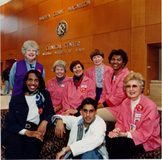 |
Some of the volunteer south entry greeters. Clockwise
from far right are Ruth Jones, Aushkon Foroutan, Kim Mitchell,
Evelyn Bendersky, Peg Wintz, Aurora Cruz, Lee Kush, and Janet
Salkey. Not pictured are Ruth Graves, Feven Kiflu, Mary Meikle,
Jean-Luc Pierre-Louis, Maribel Ruiz, Susan Stevens, and Melissa
Turgusen. |
| |
|
|
|
At the volunteer recognition luncheon, Dr. Harvey
Klein (far left), chief of the Department of Transfusion Medicine,
made a special presentation to the family of the late Mary Maze,
a Blood Bank and Red Cross volunteer who passed away late last
year. Pictured with Dr. Klein (from left) are Susan Kelly, Maze's
niece; Chester Maze, her husband; and Marianne Maze Bullen, her
daughter. |
|
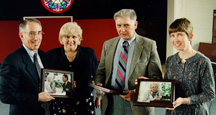 |
Pointing the way
Volunteers greet and orient visitors at the south entry
The new south entry may be sunny and bright, but visitors
who successfully navigate that newfangled revolving door may
still need some help finding their way.
Fortunately, the Clinical Center has a devoted cadre of volunteer
greeters who staff the information desk with a smile and the
way to go.
"Our volunteers are amazing," said Andrea Rander, coordinator
of volunteer services. "The energy, the time, the talent,
and the creativity too, are such an asset to the Clinical Center."
Rander recruited more than a dozen greeters to staff the south
entry. All are relatively new to the Clinical Center. Despite
the customary tour and orientation, the group had some quick
on-the-job training once those questions started pouring in.
"They really did well with it," said Rander, "and
they had help from the transportation staff, who sit right next
to them and are used to handling lots of questions."
Four students are among the group, pitching in on weekends
and fulfilling their Student Service Learning requirements to
boot. Others are retirees, NIH employees, and Red Cross volunteers,
who help out in a pinch.
Lee Kush is a retired NIH employee who returned as a south entry
greeter. "I know the kind of quality research and hospital
care that goes on here, and I thought it might be nice to lend
a helping hand," she said. Kush also volunteers at the Smithsonian's
information desk, and said that experience made her at ease with
greeting the public. "I enjoy it, it's fun, and I try to
give something back," she said.
Although Kush is not new to NIH, she was new to the Clinical
Center. "It's the easiest building to get lost in,"
she said. "People who are used to coming in the north entrance
get turned around. But with the map we have, it's very easy to
straighten them out again," she said.
Ruth Jones is another south entry greeter. "I used to
be an NIH patient," she said. "I had always thought
about hospital work, and the Clinical Center is familiar to me."
That familiarity comes in handy when visitors arrive with incomplete
information about their visit. "You have to dig a little,
without asking their diagnosis, to find out where they need to
go." Sometimes, Jones said, the visitor is actually looking
for nearby Suburban Hospital or the Naval hospital.
In addition to greeting the many visitors to the hospital,
Clinical Center volunteers serve as language interpreters, run
the flower and gift shop, and work in many different departments.
The varied functions CC volunteers fill are an asset in some
pretty concrete terms. According to Rander, in 1998, CC volunteers
logged about 75,000 hours and saved the Clinical Center almost
a half million dollars in personnel costs.
In appreciation for their many contributions, volunteers were
honored last month at a celebration at the Bradley Hills Presbyterian
Church in Bethesda. Volunteers enjoyed a luncheon, awards ceremony,
and entertainment provided gratis by singer Hannah Fae Jackson.
index
|
|
|
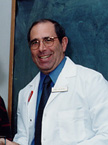
Looking back; looking ahead
CC Director John Gallin at the 5-year mark
May 1 marks the 5th anniversary of Dr. John I. Gallin's tenure
as director of the Clinical Center. As the construction cranes
swung and the bulldozers droned outside his office window, Dr.
Gallin chatted with CCNews last month about the many changes
that have occurred during his years here, and what he sees for
the future at this crucial time in the CC's history. Part I of
II.
___
CCNews: You've been the director of the CC for 5 years
now. What was it about the position that made you want to take
it on?
Dr. John I. Gallin: It was a reflection on 20 years in
the institution and spending my whole life doing clinical investigation,
and having served as an administrator in the Allergy and Infectious
Diseases institute. I felt well poised to address the challenges
that were facing the Clinical Center, which at the time, I thought
were substantial because of the decline in the level of activity,
the decline in morale, and my belief that things had to be done
to reverse it or the Clinical Center was in danger.
CCNews: When you came on board, did you have a specific
agenda, or a broader idea of the things you wanted to achieve?
JG: Clearly the agenda was broad, but there was some specificity
in that broadness. It was quite clear that we needed a new hospital
and that that was going to take a certain amount of effort to
try to mobilize the resources to make that happen, and to work
with Dr. Varmus to make that happen. It was quite clear that
attention had to be paid to training tomorrow's clinical investigators-and
today's clinical investigators. It was quite clear that the whole
administrative apparatus of the Clinical Center needed to be
reviewed and possibly updated.
CCNews: How much time does this position leave you
for your patient care and research activities?
JG: Not enough. I find that I spend about an hour a day
in patient activities and then several hours during the day for
my laboratory, but it's spread out, with a half hour here, a
half hour there. I probably spend a total of 2 to 3 hours a day
on patient and research activities.
CCNews: Many changes have occurred at the CC since
you became director. New programs, educational opportunities,
changes in the governance structure, the formation of alliances
with community hospitals, and some outreach efforts. What do
you see as some of the most significant achievements of your
administration?
JG: Probably the most lasting is working to get the new
hospital, which was not just an effort by the Clinical Center,
but was an effort by the entire NIH and everybody else involved
in government who contributed, from the Secretary to the Congress
to the President. So in terms of things that happened during
[the five years], I think the initiation of that project may
be the most long-lived.
The other significant things that have happened, I think,
are the changes in the governance of the hospital, the creation
of the Board of Governors, and having a pretty close relationship
with the Office of the Secretary, which I think was a new event
for the hospital. Clearly this has brought about an opportunity
for outside leaders in medicine and management of hospitals to
provide some help in terms of where we're going.
In terms of what's happened to people here, for physicians,
the most significant event has been the change in salary structure,
Title 38 and Title 42, but particularly Title 38, which was the
first event that enabled the salaries for doctors to be competitive
with some of our neighbors. It's enabled us to begin retaining
and recruiting to the level of talent that we need here.
The changes in the administrative structure, I hope, will
have a lasting effect-in trying to flatten the administrative
structure a bit, and to empower the department heads as a whole
with certain responsibilities related to, for example, managing
their personnel to salaries, rather than FTEs. And the creation
of a centralized administrative management apparatus, I think,
has the potential to be long-lived and have an effect.
Then training the development of a curriculum in clinical
research two things there I feel good about: One is the
core course, the "Introduction to the Principles and Practice
of Clinical Research," as well as the experiment in long-distance
learning, providing a master's program in clinical research,
where the degree is conferred by Duke, with the students present
here through telecommunications. The other courses that have
been established, including the clinical pharmacology course,
are pretty substantial.
Some of the departmental reorganization issues we feel good about,
including the creation of the Radiologic and Imaging Sciences
Program, to provide a clinical presence in imaging in a dominant
way on the NIH campus, is a very positive event. And the creation
of the Clinical Bioethics Program, through recruitment of Zeke
Emanuel to run that, is timely and much needed, and provides
the opportunity for the NIH to be a leader in that arena.
Another area that's important is the establishment of a stem
cell harvesting facility in the Transfusion Medicine Department
to enable clinical translation of the gene therapy opportunities
into patients and also to begin work on hematologic stem cells.
That just opens up all sorts of opportunities.
So, what we've been trying to do is to modify the infrastructure
here to make it ideal. And I guess behind all of this, and driving
it, is the writing of a strategic plan for the Clinical Center.
There never had been a formal strategic plan. That's been a very
helpful tool to set the road maps of where we want to go.
CCNews: What has been the greatest challenge you've
faced during your years here?
JG: Communication within the Clinical Center and between
the Clinical Center and the institutes. With the 15 institutes
sharing in the use of the hospital, and then the almost 2000
people who work for the Clinical Center, 4000 people who work
in the building in addition to the 2000, communicating with people,
having them understand what the issues are and what the opportunities
and alternatives are in terms of decision-making, that's the
biggest challenge. And that's linked to trying to boost morale
and have people think positively and be enthusiastic. I think
with all the construction that's going on around the hospital,
both with the new Hatfield Clinical Research Center and for the
other buildings in the immediate geography, that's had a real
downer effect. But communicating that this is happening, and
that all the positive things will happen, that's been the biggest
challenge.
CCNews: To assist you in all these challenges,
what is your guiding philosophy toward managing the Clinical
Center?
JG: I think the key to management for me has been in trying
to delegate responsibility to the right people and empowering
them to do things, because then you have multiple people who
are able to reach out and communicate; one person can't possibly
do it.
The other point I would raise in terms of management is trying
to show a presence and walk the halls, so to say, and to interact
with all people at all levels of the organization. It's hard
to do, but it's important. I find that when you do that, and
if you can explain to people why things have to be done and it
makes sense-if it makes sense-then people are willing to try
and make it work. If you just go to them and say 'this is the
way it will be,' that almost never works. It's just a human instinct
of saying 'well, I don't understand,' or 'why?' So the more you
can successfully communicate what you are doing, the better.
In terms of managing the hospital, one group that has been
particularly helpful that we've created in the last few years
has been the Clinical Center Advisory Council, which has seven
members. Four of the regular participants are Institute directors,
who come here and meet with me every other week and just talk
about issues and directions. They've been particularly helpful
in vetting ideas and then implementing events. For example, they
were particularly helpful in creating an apparatus for planning
the new hospital. The creation of partners groups, where representatives
from each institute who would be present on each floor, formed
a small governance team that has helped to plan what's going
to be in the new hospital, and hopefully help to govern each
of the patient care units in the new hospital.
The other thing is responding to telephone calls and emails.
I spend a fair amount of effort responding rapidly to emails.
It seems a valuable tool for communicating and managing. I get
emails from all levels. People tell me whether people are smoking
around the building, or where there's a messy room in a patient
care area, or where a hallway has ice cream spilled on it or
is slippery. I mean, I hear everything. And it's helpful because
I can forward messages as appropriate to people.
In terms of morale building, one of the things we did that
I think has probably made a difference is to try to improve the
appearance of the building-hiring a painter to walk around and
paint constantly-probably has helped in the consciousness of
keeping the hospital clean; sending housekeeping department staff
out to other hospitals to see how other people do it is probably
helpful, and trying to provide some awards and incentives for
good work.
Next month, Dr. Gallin talks about what the future holds for
the Clinical Center, and for himself.
index
|
|
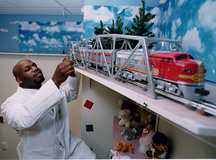
Phlebotomist Richard Gourdine adds a finishing touch of an
evergreen tree to the choo-choo train set he installed in the
blood-drawing area. The realistic train, some cuddly toys, and
cartoons help distract and entertain pediatric patients during
blood draws.
Choo-choo train lifts spirits
CC phlebotomist eases children's fears with child-friendly
environment
In a day when budget cuts are a fact of life in the CC, one
employee didn't let that get in the way of making his dream for
young CC patients become reality.
His dream, honorably enough, was to build a train track in
the child-friendly blood-drawing area in Phlebotomy. One that
could help distract the little ones and ease the pain and fears
of having their blood drawn.
But the reality was that in order to build the track, Richard
Gourdine, phlebotomist, would need to pick up a part-time job
to finance the endeavor.
"The initial reason that my co-workers and I designed
the area two years ago was to make the kids feel at ease,"
said Gourdine. "The train was in essence a completion of
my dream for the room."
The effort has attracted the attention of patients and staff
alike who marvel at the speed and real-life sounds of the set.
"The kids are in awe of the train," said Gourdine.
"It really helps take the trauma out of having blood drawn
because the kids are occupied by the same exciting sounds that
they might hear from a real train."
Although Gourdine financed the project through his part-time
job, he acknowledges his supervisor and co-workers, such as Leslie
Berry and Matthew Corley, for their support. "Also without
the CC Safety Office and several others, including the painters,
this project could not have gotten off the ground," he said.
Which is literally true since the train set stands just a few
inches from the ceiling and required construction of a special
ledge in the room.
Crucial to designing and setting up the set were David Rogerson,
chief of the elevator unit of the NIH Maintenance Engineering
Section, and Jim Powell, mechanic in the unit, as well as Wayne
French in the Public Works Office. "Without the help of
these people the project might have taken longer and been more
difficult," said Gourdine.
So what exactly is it that inspires a worker to do something
like this? "This was just something that I had to do for
the kids," said Gourdine. "This is my way of giving
back." With such a dedicated staff person as this, who knows
what will come down the track next.
-by LaTonya Kittles
index
|
|
Radiology's Hilda Stofko retires
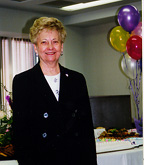 The Diagnostic Radiology
Department bade farewell to longtime secretary Hilda B. Stofko,
who retired in March. The Diagnostic Radiology
Department bade farewell to longtime secretary Hilda B. Stofko,
who retired in March.
Her career spanned more than 50 years, most of it spent in Federal
service. "When I graduated from high school in Baden, Md.,
at the age of 17, I went directly to work for the U.S. government,"
she said. "Except for a leave of absence to raise my son
and then my daughter as babies, I have been employed full time.
I really enjoy working."
From 1984 until Sept. 1991, Stofko was secretary to Dr. John
L. Decker during his term as director of the Clinical Center.
She technically retired for the first time in Sept. 1991, but
continued to work at the Clinical Center as a member of the radiology
department contract staff under Dr. John L. Doppman.
"Hilda Stofko was a wonderful administrative assistant without
whom I could have never managed the Radiology Department,"
said Dr. Doppman.
When that contract expired, Stofko resumed her status as a
Federal employee and continued on with the Radiology Department.
When Dr. R. Nick Bryan arrived from Johns Hopkins as the associate
director for radiologic and imaging sciences in early 1998, Stofko
stayed on to help orient him to the ways of the Clinical Center.
"Hilda was invaluable to me for two main reasons,"
Dr. Bryan said. "First, she was superb in 'people handling.'
And second, she knew everyone, which is invaluable knowledge
to a newcomer like me. She knew everyone and she could keep them
all happy."
In addition to her service to the Clinical Center, Stofko
worked for NIAID, OD, OASH, and NIDR.
Although she admits that retirement might be "an adjustment"
after so many years of full-time work, Stofko has plenty of plans
to help ease the transition.
"My husband James and I plan to spend some time at our
two children's homes and become fully acquainted with our five
grandchildren," she said. "We also intend to do some
traveling around the country to visit numerous relatives in various
cities who we have not seen for many years. We hope to take some
extended vacations that we have put off for years, including
some overseas trips. I expect to have a very busy schedule over
the next several years, catching up with all the things we have
wanted to see and do."
index
|
|
CC RoundTable to discuss breast cancer
On May 21 at noon in Lipsett Amphitheater, Clinical Center
RoundTable presents "Current Issues in the Management of
Breast Cancer."
Panel leader Joanne Zujewski, M.D., NCI, will be accompanied
by Patricia Steeg, Ph.D., and Sandra Swain, M.D., both also with
NCI.
Clinical Center RoundTable is a monthly program broadcast
live from the Clinical Center.
Each one-hour program features a panel of physician-scientists
from NIH and the surrounding community in an in-depth discussion
of the latest clinical research on each topic.
Dr. John I. Gallin, Clinical Center director, moderates the
discussions, and viewers are encouraged to call in with questions
and comments. Programs are scheduled for the third Friday of
each month and begin at noon. (No programs are scheduled for
July and August.) All are welcome to attend.
index
|
CC Factoid: What's in a name?
A joint Congressional resolution signed by President Jimmy
Carter in 1980 attached "Warren Grant Magnuson" to
the Clinical Center's full name. Congress directed the name change
as a tribute to the congressman from Washington heralded as the
"Commander in Chief" in the war against cancer and
heart disease.
As a freshman House member, Magnuson sponsored the legislation
that created the NCI. He spent the next 44 years - 7 in the House,
37 in the Senate - as a champion of similar causes.
With Carter's signature, the resolution became Public Law
96-518. In announcing the honor, President Carter said of Magnuson:
"He has had an unwavering commitment to the idea that progress
in health care depends on research."
index
|

A clearer way to go
"Sign, sign, everywhere a sign." That old song could
be the theme for the NIH campus during all this construction.
But soon, look for a new series of signs to replace the hodgepodge
of temporary directional signs that have sprung up all over.
The new signs provide a standard design and cranberry color to
help visitors locate appropriate parking areas and the relocated
main (south) entrance. Arrows will be moveable to accommodate
construction-related route changes. The signs are planned for
all major intersections, and will remain in place until the new
Mark O. Hatfield Clinical Research Center is completed.
index
|
|
News briefs
Work and family
The Work & Family Life Center will sponsor the following
events in May:
Retirement: Life After NIH
Thursday, May 13
noon to 1 p.m.
Bldg. 1, Wilson Hall
What are you going to do with your 40 hours after retirement?
Brian Easley, Work & Family Life Center career counselor,
will identify issues, concerns, and ways to explore post-retirement
career and activity options.
Divorce Recovery and Elder Care Brown Bag Discussion Groups
Both meet from noon to 1 p.m.
Bldg. 31, Room B2B57
Wednesday, May 12
Wednesday, May 26
Family Violence:
It's Not Just at Home Anymore
Tuesday, May 18
1 p.m. to 3 p.m.
Bldg. 31, Room 6C10
To pre-register, call 5-1619. For reasonable accommodations,
call at least one week before the event.
Fee lowered
The registration fee for the May 11 and 12 conference entitled
"Socioeconomic Status and Health in Industrial Nations:
Social, Psychological, and Biological Pathways" has been
reduced for NIH staff from $170 to $100. The fee includes lunches,
reception, scientific sessions, and the resulting book from New
York Academy of Sciences. This conference will be held in Natcher
Auditorium and is co-sponsored by the Office of Behavioral and
Social Sciences Research, NIH.
To receive the reduced rate, staff should be sure to PRE-REGISTER.
Refer to the following website for registration information:
http://www.nyas.org/brochses.htm.
Mammograms
Mobile mammography screening at NIH starts this month. All
NIH employees, their families, and others associated with NIH
(such as IRTAs, visiting scientists, contractors, volunteers)
are eligible. Dates and van locations are:
Bldg. 31 (Lot 31D): May 6, 20
Bldg. 45 (front of building): May 1, July 15
Rockledge (visitor parking behind building): June 2
EPN (parking lot behind building): May 14
Bldg. 10 (Lot 10H): May 7, 19
The van will be at each site from 9:30 a.m. to 4 p.m. To schedule
an appointment, call the George Washington University Breast
Cancer Center at 202-994-9999. Refer to the following web site
for any updates in schedule or location:
http://rex.nci.nih.gov/MAMMOG_WEB/MAMMOG_DOC.html
Screenings are conducted by female technologists, and a board-certified
radiologist specializing in mammography will interpret the films.
The results will be reported to you and your doctor. Each screening
takes about 20 minutes and costs $138.00.
GW will bill the following insurance companies directly:
Aetna PPO, Blue Cross/Blue Shield National Capitol Area (check
with your plan manager), Cigna Indemnity, Aetna Indemnity, Mail
Handlers, Prudential, John Hancock, NYL Care Passport PPO, Medicare,
DC Medicare, GWUHP (with referral). Subscribers to other insurance
programs can pay by check or credit card at the screening and
submit a request for reimbursement to the health insurance plan.
(HMO members, check with your plan manager to ensure that your
mammogram will be covered).
Register now
Register now for two June courses offered by the Education
and Training Section of the CC's Office of Human Resources Management.
May 12 is the last day to register for the June 2 course, "Managing
Conduct and Performance." This course, designed for supervisors
and managers, is scheduled to correspond with the mid-year performance
review cycle. It will assist supervisors and managers in addressing
performance and conduct issues in a positive, timely, and effective
manner.
May 26 is the last day to register for the June 1617 seminar,
"Mid-Career Retirement Planning," designed for CC employees
with 10 to 15 years of service. It will highlight the foundations
of retirement benefits available within Federal service and options
for maximizing them. Topics include CSRS and FERS; Social Security;
and Thrift Savings Plan, among others.
Both classes will be held at 6100 Executive Blvd., Room 3E01.
Call
6-1618 to register by the deadlines.
Suggestions, please
The CC Quality of Worklife Council is designing a website
and would like to hear from you about the topics you would like
to see addressed. Drop your ideas for the website, or any other
suggestions, in the Council's suggestion box, outside the B1-level
cafeteria.
index
|
Editor: Sue
Kendall
Clinical Center News, 6100
Executive Blvd., Suite 3C01, MSC 7511, National Institutes of
Health, Bethesda, MD 20892-7511. Tel: 301-496-2563. Fax: 301-402-2984.
Published monthly for CC employees by the Office of Clinical
Center Communications, Colleen Henrichsen, chief. News, article
ideas, calendar events, letters, and photographs are welcome.
Deadline for submissions is the second Monday of each month.
top | cc
home page | nih home
page | |
|

